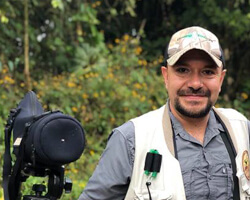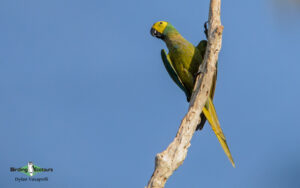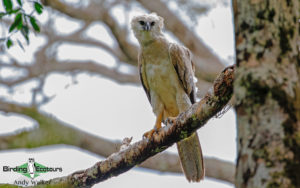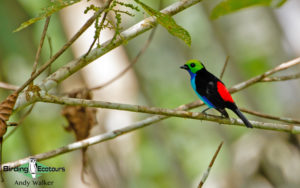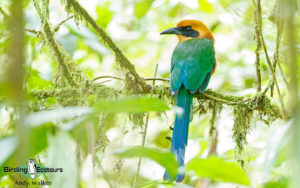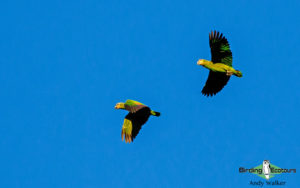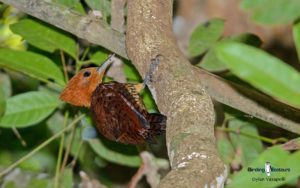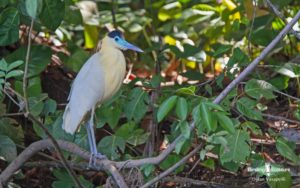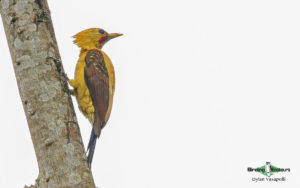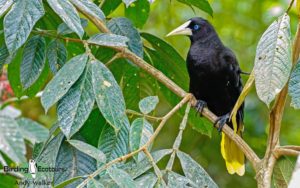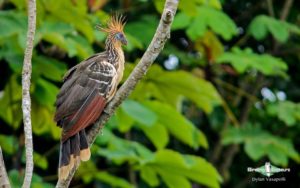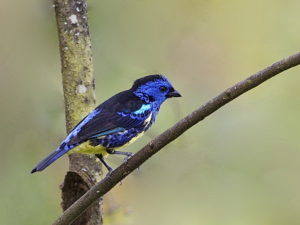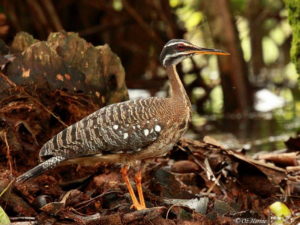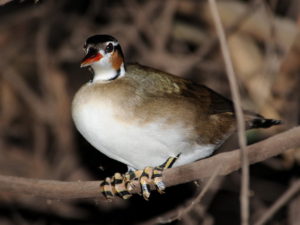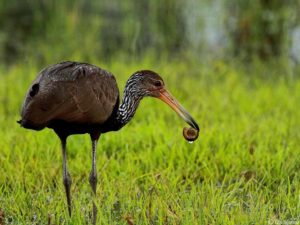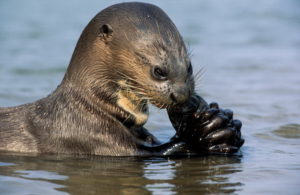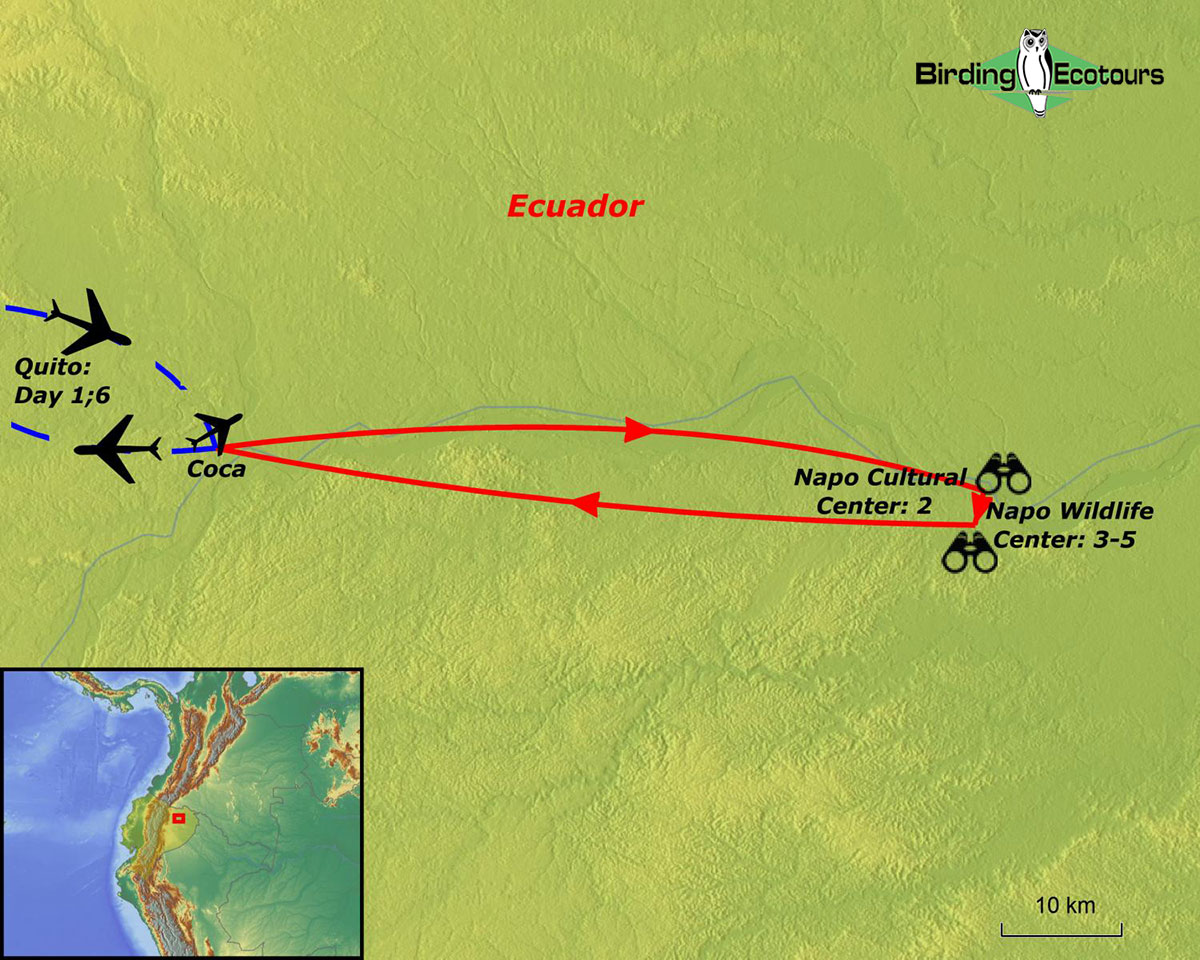Birding Tour Ecuador: The Amazon – Clay Lick and Giant Otters
Go to: Ecuador Birding Tours | Birding Tours in the Neotropics | All our birding tours
Birding Tour Ecuador: The Amazon – Clay Lick and Giant Otters
November 2024/2025
Ecuador’s Yasuní National Park is one of the most diverse places on earth, spanning nearly 2.5 million acres (2.09 square kilometers) of lush rainforest. The Ecuadorian Amazon is home to more than 600 bird species. We have developed this seven-day itinerary to provide you with the best birding experience in the Amazon. The comfortable Napo Wildlife Center will be our base for a week of birding and adventure in the heart of the Amazon rainforest. Some of the key species in the forest around the Napo Wildlife Center are Black-necked Red Cotinga, Plum-throated Cotinga, Hoatzin, Sungrebe, Agami Heron, Zigzag Heron, White-throated Toucan, Golden-collared Toucanet, Grey-winged Trumpeter, Crested Owl, White-plumed Antbird, Bicolored Antbird, Lunulated Antbird, and Pavonine Quetzal. In addition the number of parrots on the clay lick such as Scarlet Macaw, Orange-cheeked Parrot, Dusky-headed Parakeet, Southern Mealy Amazon, Yellow-crowned Amazon, and White-eyed Parakeet will be a treat.
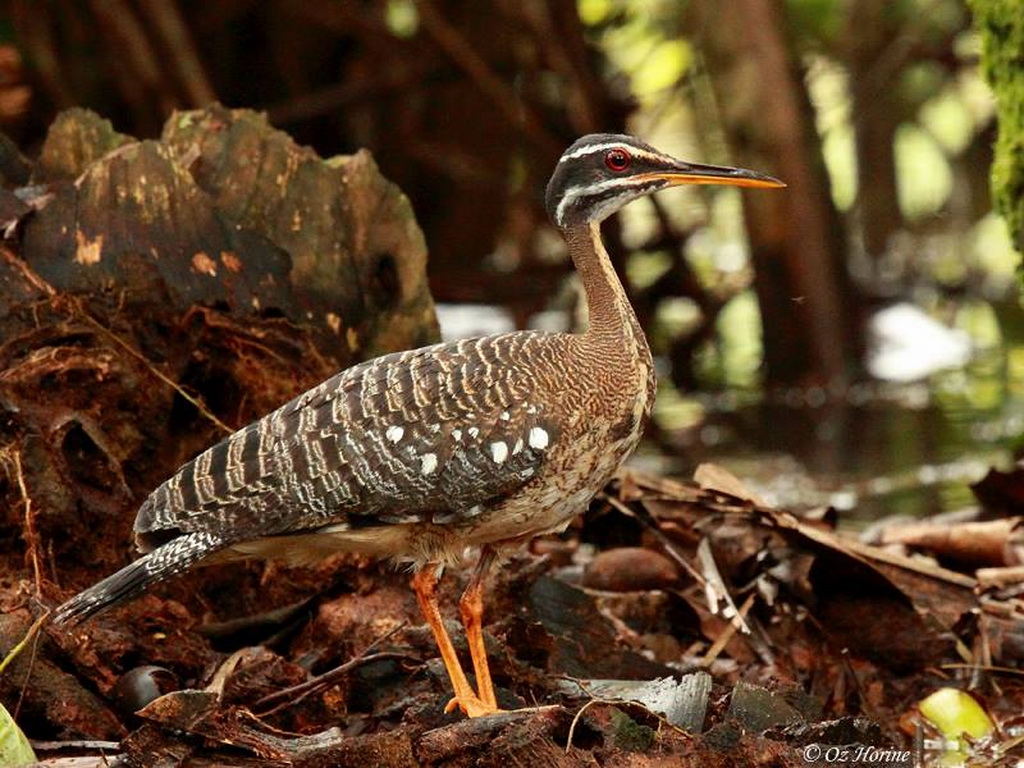
The Napo Wildlife Center offers also good opportunities to see wildlife such as Giant Otter, Black Caiman, Golden-mantled Tamarin, White-faced Capuchin, White-bellied Spider Monkeys, Red Howler Monkey, and Napo Saki monkey.
In some years, this tour can be combined with our Northern Ecuador: Birding Paradise tour, and/or our Ecuador: The Amazon tour.
Please e-mail [email protected] for more details.
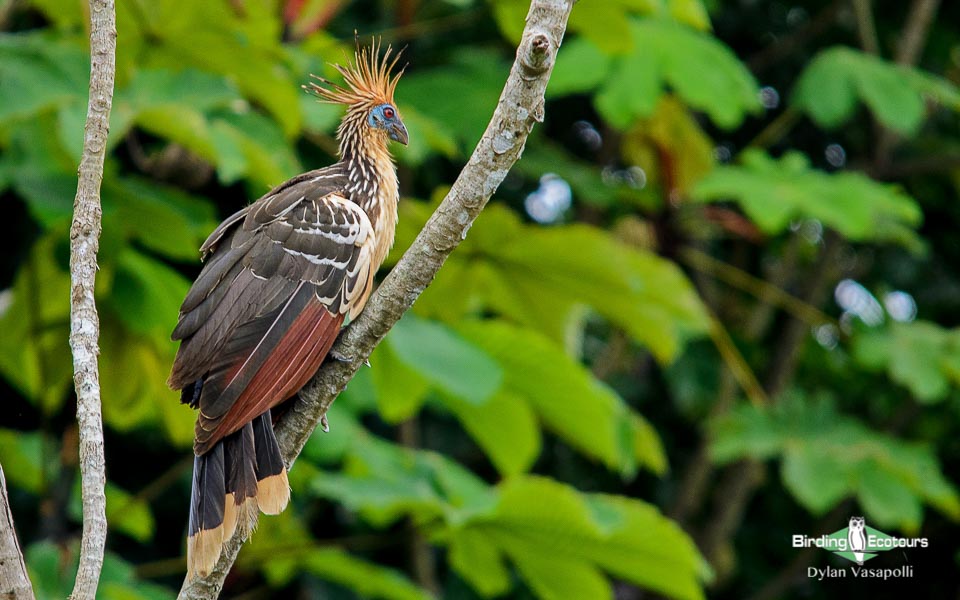
Itinerary (6 days/6 nights)
Day 1. Arrival in Quito
After arriving at Mariscal Sucre International Airport in Quito you will be met by your guide and transferred to your hotel.
Overnight: Hotel in Quito
Day 2. Flight to Coca and transfer to Napo Cultural Center
We will transfer to the airport for a domestic flight to Coca (officially known as Puerto Francisco de Orellana), and after arrival we’ll transfer by motorized canoe for two hours on the Napo River to the entrance of the Añangu River, where we will bird for about two hours before getting to our lodge. We expect to see here several aquatic species, such as Rufescent Tiger Heron, Sungrebe, Wattled Jacana, Limpkin, Hoatzin, Collared Plover, Red-bellied Macaw, Capped Heron, Anhinga, Snail Kite, Grey-necked Wood Rail, Amazon Kingfisher, Green Kingfisher, Ringed Kingfisher, Yellow-headed Caracara, Swallow-winged Puffbird, Lineated Woodpecker, and Crested Oropendola. Before we continue our trip to the Napo Wildlife Center we will look for one of the main targets of this trip, the handsome Black-necked Red Cotinga. We will stay the first night at Napo Cultural Center to have a good opportunity to be at the parrot clay lick at first light.
Overnight: Napo Cultural Center, Coca
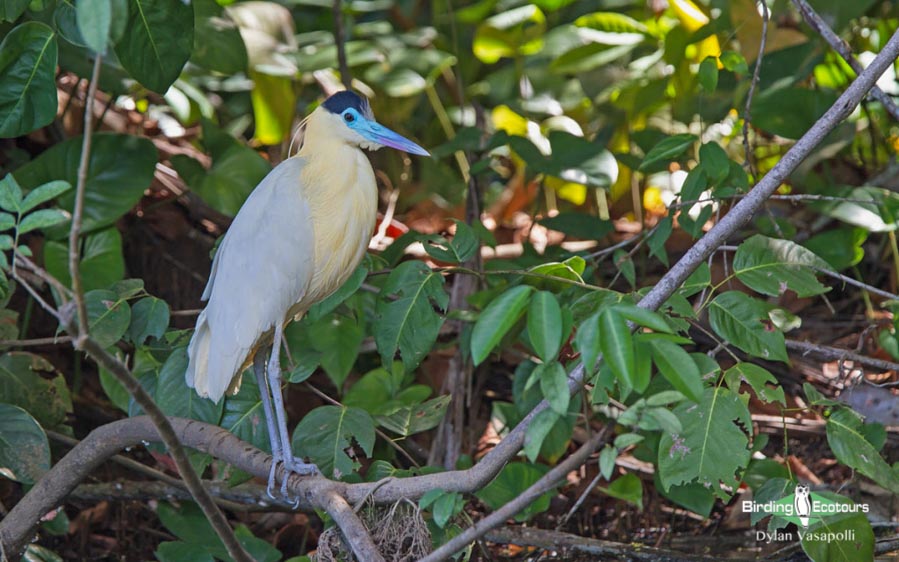
Day 3. Parrot clay lick and transfer to the Napo Wildlife Center
Today we will have an early start to visit the parrot clay lick, where we can watch several species of parrots coming every day. Usually we can observe here Southern Mealy Amazon, Yellow-crowned Amazon, Dusky-headed Parakeet, Blue-headed Parrot, Orange-cheeked Parrot, Scarlet-shouldered Parrotlet, Cobalt-winged Parakeet, Chestnut-fronted Macaw, and the impressive Scarlet Macaw. In addition to the parrots we can find other attractive species, such as Spangled Cotinga and Plum-throated Cotinga. Then we will transfer to the Yasuní National Park, looking for Greater Ani, Orange-backed Troupial, Black-capped Donacobius, Turquoise Tanager, Paradise Tanager, White-throated Toucan, Yellow-billed Jacamar, Bat Falcon, Red-throated Caracara, Southern Lapwing, King Vulture, Plumbeous Pigeon, and Blue-throated Piping Guan.
Then we will arrive at the comfortable Napo Wildlife Center. In the evening we will try to find some night birds, including Common Potoo, Great Potoo, Ferruginous Pygmy Owl, Spectacled Owl, and Crested Owl.
Overnight: Napo Wildlife Center
Days 4 – 5. Napo Wildlife Center
We will have two full days to explore the lush Amazon rainforest and the diverse habitats that it holds. During these two days we will have pleasant boat rides along the river and oxbow lakes, use a canopy tower, and do selective walks along the Amazon trails. We will focus on several species such as Undulated Tinamou, Great Jacamar, Brown Nunlet, White-chested Puffbird, Spotted Puffbird, Collared Puffbird, Pavonine Quetzal, Amazonian Trogon, Bare-necked Fruitcrow, Wire-tailed Manakin, Crimson-crested Woodpecker, Ringed Woodpecker, Scaly-breasted Woodpecker, Orange-crested Manakin, Slate-colored Hawk, Duida Woodcreeper, Lemon-throated Barbet, Many-banded Aracari, and Purplish Jacamar. In addition, we hope to see Bicolored Antbird, Sooty Antbird, Lunulated Antbird, White-plumed Antbird, Silvered Antbird, White-shouldered Antbird, and Dot-backed Antbird.
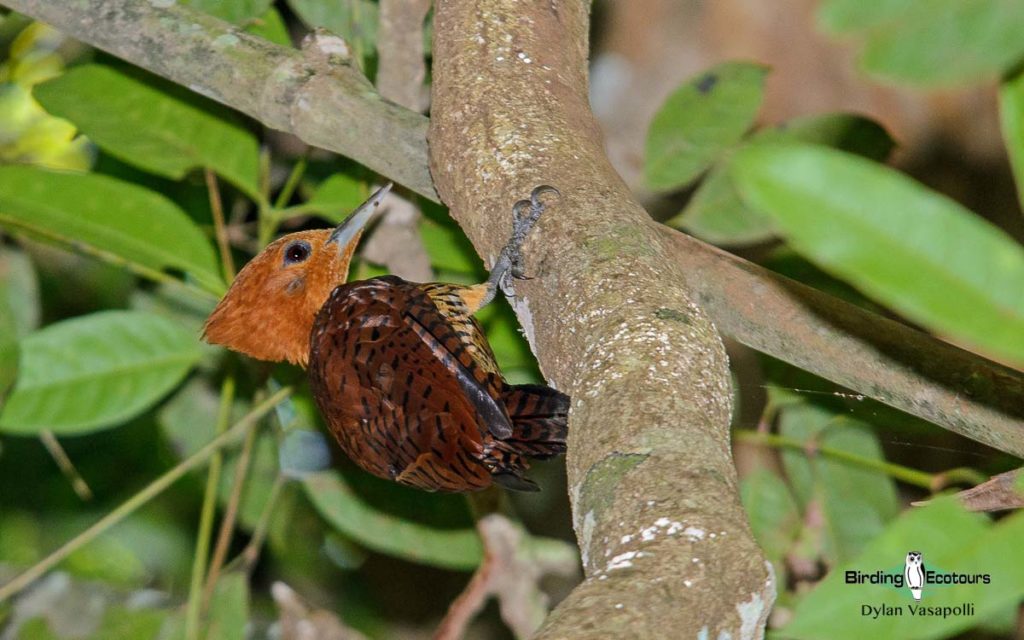
Some hard-to-find species such as Buckley’s Forest Falcon, Grey-winged Trumpeter, Grey-bellied Hawk, Zigzag Heron, and the rare Harpy Eagle are only occasionally seen around Napo Wildlife Center. However, we might still have a chance with a bit of luck. Other common exciting wildlife sightings include the most wanted Giant Otter, Golden-mantle Saddleback Tamarin, Common Woolly Monkey, Napo Saki, Ecuadorian White-fronted Capuchin, and Ecuadorian Squirrel Monkey.
Overnight: Napo Wildlife Center
Day 6. Transfer to the Coca airport and flight to Quito
After a final couple of hours birding the lodge grounds we will transfer to Coca to connect with our domestic flight back to Quito, where hotel accommodation for the night and transfer to the airport are included, as most international flights from Quito leave in the early hours of the morning. This allows you to get some rest and a shower before catching your next flight. Our Northern Ecuador: Birding Paradise – Antpitta and Hummingbird Extravaganza starts this afternoon from Quito, so you can easily combine these two tours.
Overnight: Hotel in Quito
Please note that the itinerary cannot be guaranteed as it is only a rough guide and can be changed (usually slightly) due to factors such as availability of accommodation, updated information on the state of accommodation, roads, or birding sites, the discretion of the guides and other factors.
Download ItineraryECUADOR: THE AMAZON – CLAY LICK AND GIANT OTTERS: TOUR-SPECIFIC INFORMATION
PLEASE CLICK HERE FOR GENERAL INFORMATION PERTAINING TO ALL OUR ECUADOR TOURS
The Amazon Rainforest of Napo Wildlife Center provides an amazing Ecuadorian birding and wildlife experience. This comfortable and picturesque lodge can be reached with just a short 45-minute flight from Quito and then a four-hour boat trip along the Napo River. Napo Wildlife Center serves as a perfect base to enjoy the fascinating macaw clay lick and to look for Amazon species such as Black-necked Red Cotinga, King Vulture, Red-bellied Macaw, Blue-and-yellow Macaw, Point-tailed Palmcreeper, Purplish Jacamar, White-eared and Great Jacamar, Purple-throated Fruitcrow, White-throated Toucan, Many-banded Aracari, Golden-collared Toucanet, Dugand’s Antwren, White-bellied Spinetail, Long-billed Woodcreeper and Collared Puffbird, to name a few. The area also provides other unique wildlife viewing opportunities where you can enjoy the likes of Golden-mantled Tamarin, Giant Otter, Napo Saki monkey and Black Caiman. For more information, please read our blog entitled ‘Why Choose Napo Wildlife Center’.
ARRIVAL INFORMATION
Please e-mail us before you book any flights, as the information shown here is just an initial guide.
Our tour will start and end in the city of Quito, Ecuador’s capital. You can reach Quito’s Mariscal Sucre International Airport (UIO) with direct flights from the USA, Spain, the Netherlands and Panama. You may wish to consult your travel agent to book your most convenient flight (and please do contact us if you need any guidance). Your tour leader will be waiting for you at Quito Airport (with a small Birding Ecotours signboard) and will then transfer you to your hotel. Please remember to keep your luggage tags, as they are often required to exit the terminal at the airport. Please be aware that most international flights arrive in Quito in the afternoon or evening, so we don’t have any birding activities planned for day one of the tour. If you perhaps arrive on an early flight, you will be transferred to the hotel but may then have to wait until check-in is available. For an early check-in you might be charged extra directly by the hotel; this cost is not included in the Birding Ecotours tour price.
When filling out the customs declaration form, please use this address for the hotel:
Hotel José de Puembo Manuel Burbano S7-150 y San Fernando Puembo, Quito, Ecuador
DEPARTURE INFORMATION
Our tour will end in Quito after a wonderful six days and five nights in Ecuador. On the last day your tour leader, or one of our tour representatives, will transfer you to Quito Airport from where you can connect with your international departure. Please note that we will be transferred from Coca to Quito on Day six, with that night’s accommodation included in the tour price to catch your flight home in the early hours of day seven, or to perhaps connect with another Birding Ecotours tour.
PHYSICAL REQUIREMENTS AND PACE
Birding in tropical forests is always a challenge. We have to tolerate high humidity and hot temperatures from 86°F (30°C) to 95°F (35 C), as well as thick, impenetrable forest which is often only accessible from a few forest trails. Birding along forest trails adds further complexity as there is often limited room for big parties, especially when looking for secretive species. Most of the forest trails are flat however some are slightly uneven and lead up and down hills. The Tiputini Trail could be considered the most difficult walking however it harbors some of the most interesting species of antbirds. Low light conditions within the forest interior and the presence of bugs add further difficulty to forest birding. Despite the challenges of forest birding, being based in Napo Wildlife Center will make your forest birding experience a pleasurable one and the prospect of a range of rare and interesting forest birds and wildlife right on your doorstep will add to the excitement.
Visitors joining this tour should be capable and willing to have early starts each day, with breakfast normally served around 5/5:30 am. To get the full enjoyment out of this tour, participants should be able to do the following:
- Be able to walk along forest trails. Exploring some trails may take the whole morning and we are likely to cover up to 3.7 miles (6 kilometers).
- Be able to cope with steep steps, such as at the macaw clay lick hide/blind.
- Be able to walk up the 131-foot (40 meter) scaffolding canopy tower. This is one of the main attractions of the lodge and we shall visit it on more than one morning if needed, and spend about three hours here on each visit. However, the visit is optional; you could choose to stay at the lodge if you don’t feel fit enough to get up the tower or suffer from vertigo. Please speak to your tour leader in advance to see if it is possible to arrange an extra activity for you. The canopy tower has room for 8–10 people at a time.
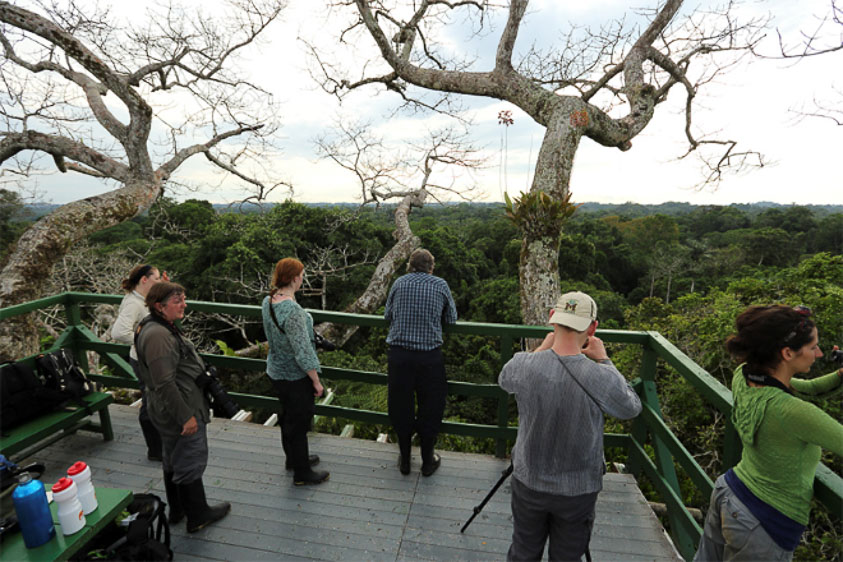
DAILY SCHEDULE
We will try to provide the best of Napo Wildlife Center even though we will only have a relatively short stay here. This tour normally involves exploring forest trails, enjoying the sights and sounds of the forest from the canopy tower, and a morning visit to the macaw clay lick. After lunches we generally have a short break, with the afternoons spent enjoying pleasant canoe and boat trips on the nearby lakes and river channels which are good areas to spot birds and wildlife, and also provide a nice cooling breeze.
ACCOMMODATION
Napo Wildlife Center is the most comfortable lodge in the region. It provides rooms with ample space, en suite bathrooms and hot showers. Electricity is available all day long. The rooms do not have air-conditioning available however they do have a fan instead. You have a mosquito net to cover your bed and are provided with a water jug in your room.
The lodge provides bar service and a restaurant. The lodge serves three meals a day, usually a buffet style. There are options for vegetarians and vegans, however please let us know of any dietary preferences in advance.
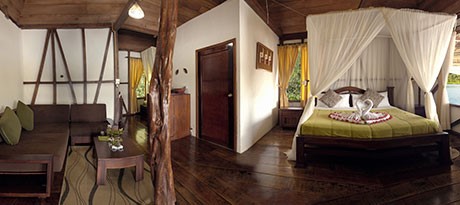
WATER
Napo Wildlife Center provides you with a complimentary water bottle upon your arrival at the lodge. You can refill this bottle any time from water containers in the dining room. Bottled mineral water from the bar is not included in the tour price.
PAYMENT METHODS
Napo Wildlife Center accepts US dollars and credit cards for extra expenses, such as your bar bill or for any souvenirs you may want to purchase.
INTERNET
The Wi-Fi at Napo Wildlife Center is not complimentary and comes at a cost of US$10 per person per stay.
ELECTRICITY
Electricity is available 24 hours a day.
LAUNDRY
Laundry service is available however please note that laundry fees are not included in the tour price.
WEATHER
Be prepared for hot and humid weather on this tour. November might bring some rainy days however, it is still a good month to see birds and wildlife. If you want to do a customized trip, be aware that during the austral winter, such as in July and especially August, there is the risk of experiencing a cold front, where temperatures can suddenly drop to 50°F (10°C), which can make wildlife observations difficult.
TRANSFER TIMES
- Domestic flight from Quito to Coca: 45 minutes.
- Motorized boat trip from Coca to Napo Cultural Center: 2 hours.
- Canoe trip from Napo Cultural Center to Napo Wildlife Center: 2 hours.
- Napo Cultural Center to the macaw clay lick: 20-minute boat trip and a 30-minute walk.
- Napo Wildlife Center direct to Coca (final morning): 4-hour river trip.
- On our final morning, the boat usually leaves Napo Wildlife Center between 05.30am and 06.00am to be at Coca with enough time to catch a flight back to Quito.
INSECTS & OTHER PESTS
Bugs are common in tropical forests. As such, your rooms have screen windows and mosquito nets to protect your bed. We recommend you bring insect repellent, wear loose-fitting pants and long-sleeved shirts and keep insect repellent handy. Spraying your feet, socks and shoes and the lower portion of your pants will help reduce chigger bites. Thankfully there are no leeches in the Amazon Rainforest.
Please always follow your tour leader’s advice about where to walk, and be particularly aware of where you place your hands on handrails at hides/blinds and while walking up the canopy tower. We do not advise walking with sandals in the grass or forest. Be aware of ants, wasps, bees, sand flies, and tiny sweat bees. If you are allergic to insect bites, we ask you to bring and carry your medication at all times as well as your medical prescription in case you need to check with a local doctor.
SAFETY
Please follow your tour leader’s advice at all times with regards to safety. We ask you to not enter the forest without a guide, especially at night. Even though vipers occur in low densities in this part of the Amazon Rainforest, highly venomous Bothrops Aspers (Fer-de-lance) snakes do occur along the forest trails and we should be careful of where we walk.
WHAT TO BRING
Please kindly refer to our general list of what to bring on a birding tour, here. Although please note that you are unlikely to need warm clothing on this tour, as we are only likely to experience hot and humid conditions in the Amazon Rainforest.
PHOTOGRAPHY
Please note that flash photography is not allowed at the macaw clay lick, and it is best to check with your tour guide before using flash photography at any location on this trip.
Even though general bird and wildlife photography is welcome on all our tours, they are primarily organized as birding-focused tours, so we ask you to photograph without jeopardizing other tour participants’ views and general enjoyment. We invite you to read our expectations and rules for group tours, in particular Point 6, which pertains to photography
MACAW CLAY LICK
Watching macaws ingesting salt and minerals from the clay lick is one of the highlights of any Amazon wildlife tour in Ecuador and southern Peru. Normally parrots and macaws visit this particular clay lick on a daily basis however, this wildlife show may be halted by several factors such as bad weather (rain), the presence of predators, or any natural and/or human disturbance. You will be asked to follow certain rules at the clay lick such as remaining silent, not using flash photography, and to ensure you are in the hide/blind before the parrots arrive. On some occasions, people do have to wait up to two hours for the parrots to arrive. If you feel you do not have the patience to wait this long, you might reconsider joining this activity, as once you are in the hide/blind, you cannot leave until the show is over. We cannot guarantee a successful clay lick morning but do have the opportunity to visit on another morning if needs be. The hide/blind is located about 30 feet (10 meters) from the clay lick. Please bear in mind that the clay lick does not belong to Napo Wildlife Center and so we will not have exclusive use of the hide/blind and will have to share with other lodges’ visitors.
LUGGAGE LIMIT
Usually, you can only take one piece of luggage (maximum 50.7 Ib/23 kg) as checked-in luggage and one piece of carry-on luggage (maximum 22.4 Ib/10 kg), without incurring any extra costs. We ask you to check with us before the trip to see if there are any new regulations regarding luggage limitations. Any extra costs incurred due to excess luggage weight will not be covered by Birding Ecotours. If you are visiting Napo Wildlife Center as part of a back-to-back trip in Ecuador, you can easily store extra luggage (not needed in the Amazon) at Jose de Puembo Hotel in Quito. For photographers who carry large and fragile optics, that surpass carry-on luggage limitations, and do not want to check it in, you may consider purchasing an additional flight ticket to fit the camera bag on a plane seat.
Download The Amazon – Clay Lick and Giant Otters Tour Information
‘We birded with Galo Real for eight days in Ecuador as an extension from a family trip to the Amazon Basin and the Galapagos. He is a good birder with a great ear for the bird calls and knowledge of all sites. He is very agreeable and was patient and considerate of our needs and capabilities. We look forward to birding with him again.’
Jim and Barbara
